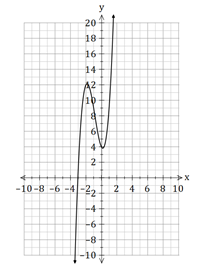I have been thinking about cubics a bit lately because some of my students are solving and then sketching cubics. Plus I am reading An Imaginary Tale by Paul Nahin, which talks about solving cubics and complex numbers.
Cubics must have at least one real root. If one of the roots is a rational number, then we can use the Factor and Remainder Theorem.
For example,
Solve ![]()
| We know the root(s) must be a factor of I always start with Try Then we can do polynomial long division. Now we know that And we can factorise the quadratic (or using the quadratic equation formula) |
But what if it is not factorisable?
For example,
Solve ![]()
How many roots does this equation have?
We could find the derivative and find out how many stationary points the function has.
![]()
This is a quadratic function. Find the discriminant to determine the number of roots.
![]()
As ![]() , there are two stationary points, which means we could have 1, 2 (one root is repeated) or three roots, depending on if the function crosses the
, there are two stationary points, which means we could have 1, 2 (one root is repeated) or three roots, depending on if the function crosses the ![]() axis between stationary points. So not much use.
axis between stationary points. So not much use.
We could try the discriminant of a cubic.
![]()
![]()
The discriminant is negative so there is one real root.
From my reading, we need to turn the cubic into a depressed cubic (cubics of the form ![]() ).
).
We can do this by using a change of variable.
| Let Substitute |
We can then use Cardano’s formula
![]()
We can see from the sketch below that there is only one solution and it is about ![]() .
.

